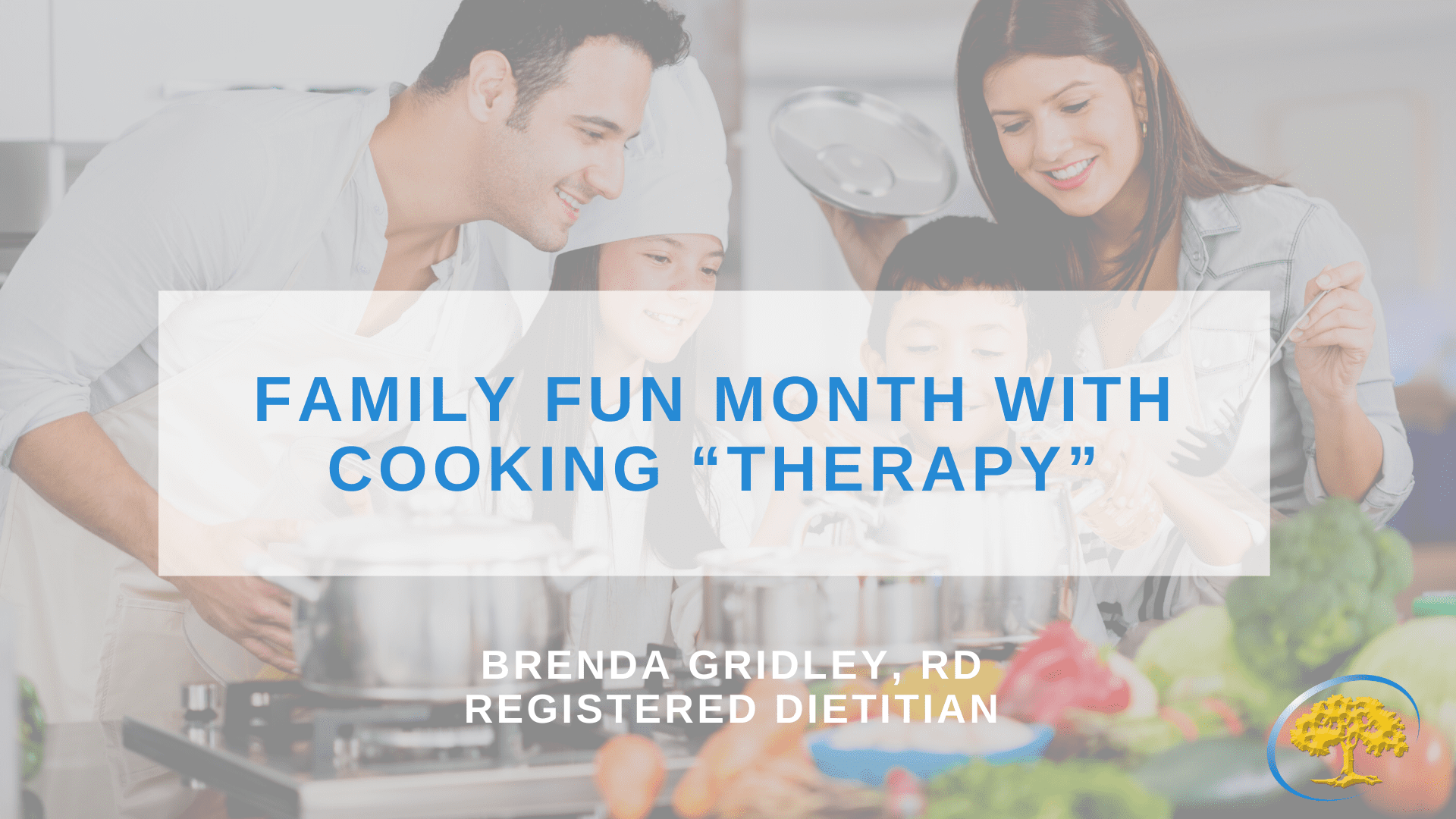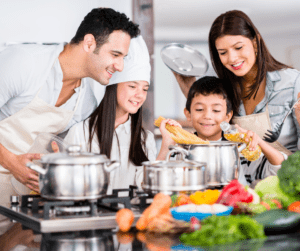
Posted 2 years ago
Family fun month with cooking “therapy”
August is Family Fun Month which makes it the opportune time to enjoy family with extra fun and activities! So why not start a tradition and make some memories with cooking? When you cook together, it’s a chance to press pause, tune out distractions, and tune into each other with the added benefit of exploring new recipes, ingredients, flavors, all while producing a scrumptious end product of nourishment.
Benefits of Cooking
- Physical benefits of cooking — Compared to sedentary hobbies like reading, watching TV or working on the computer, cooking and baking require you to be up on your feet, fetching ingredients, mixing, chopping and cleaning up afterward. It might not be an intense workout, but a cooking session is one way to do something that’s both fun and relatively active at the same time. It’s even been shown to decrease the risk of disability, loss of independence and malnutrition among elderly adults, since it requires multiple physical and mental skills to be utilized simultaneously.
- Benefits of cooking together as a family/couple — You might normally think of meal planning, cooking and cleaning up the mess as a hassle, but research suggests that exploring recipes together with your family/partner, planning and then cooking the meals as a team can actually be a fun way to gather, bond and enjoy time together.
- Saving money — If you typically rely on takeout and convenience foods, cooking more meals at home is a great way to eat healthy on a budget and start saving money. Cooking with seasonal, local produce is another money-saving solution, since not only are the ingredients fresh and taste great, but they may be cheaper too. Another way to keep costs down is to take inventory of ingredients you already have and then come up with creative new ways to use them. Can you say Goulash? 😊
- Eating healthier — Many studies have found that when people cook for themselves at home, they tend to consume less calories overall and eat better-quality foods. If you take the time to carefully prepare a meal, you’re also less likely to zone out while eating and more inclined to practice mindful eating, take your time and pay attention to your hunger and fullness cues.
- Supporting overall cognitive health — Studies have shown that when adults focus on eating simple, anti-inflammatory foods like greens, berries, nuts, seeds and fish, they tend to experience benefits related to their general well-being, including:
- Reduced oxidative stress/free radical damage
- Lower inflammation
- Protection against dementia, cognitive decline and Alzheimer’s disease, heart disease, weight gain, Cancer and metabolic syndrome.
- Improved blood sugar
- Lowered risk for obesity
- Improved mobility and quality of life
So, What Is Cooking Therapy?
Cooking therapy/culinary therapy has been defined by experts as “the therapeutic technique that uses arts, cooking, gastronomy, and an individual’s personal, cultural, and familial relationship with food to address emotional, physical and psychological problems.”
Cooking therapy can improve your mood and general well-being by:
- Requires concentration, so can act a healthy distraction that allows you to slow down and “get out of your head.”
- Can serve as a form of mindfulness. Cooking is a kind of meditation with the promise of a good meal afterward.
- Awakens your senses, requiring you to pay attention to the present moment.
- Can help you get into a “flow state,” since it’s both challenging and enjoyable at the same time.
- Encourages you to learn new skills and expand your knowledge base.
- Provides an “escape” and breaks up the monotony of your daily routine, since there are always new recipes to try.
- Can improve quality of life among people coping with addictions and serious illnesses, such as cancer.
- May help you feel less anxious, depressed or overwhelmed, since cooking gives you a feeling of accomplishment and can also provide pleasure. Additionally, it’s a way to practice gratitude for the food available to you and can give you a boost in self-esteem if you take the time to appreciate and enjoy what you’ve made.
Both baking and cooking give you outlets to express yourself and produce something tangible of substance. It’s an added bonus that you can eat and share your work of art!
Healthy Foods to Include
One way to take the benefits of kitchen therapy to the next level is by preparing healthy, nourishing recipes that you can feel good about eating and sharing. Nutrient-dense foods are also supportive of cognitive/mental and physical health. Try to include these in your family recipes…
- Vegetables: spinach, kale, broccoli, Brussels sprouts, peppers, tomatoes, carrots, mushrooms, green beans.
- Fresh fruit, especially all types of berries, including strawberries, blueberries, raspberries, blackberries, cherries, cranberries.
- Nuts and seeds, such as walnuts, almonds, chia seeds and flaxseeds
- Beans and legumes, such as chickpeas, black beans, lentils.
- Whole grains, such as oatmeal, quinoa, brown rice, barley, farro, 100 percent whole-wheat breads.
- Fish, particularly wild-caught, fatty fish like salmon, sardines, halibut, trout, tuna and mackerel, which are the best sources of omega-3 fats.
- Lean meats like poultry, ideally that are pasture-raised and not breaded or fried.
- Olive oil, which is used as the “main cooking oil” and can also be drizzled over salad, veggies.
- Bone broth (can be used in soups, stews, marinades, omelets and even baked goods)
- Beetroot powder (great in smoothies, sauces, salad dressings and gravy)
- Cassava, tiger nut, banana and chickpea flours (try these gluten-free flours in baked goods, flat breads and more)
- Freekeh (an ancient grain that can sub in for buckwheat, quinoa or farro)
- Kombu (a type of seaweed used in soups, stews and salads)
- Natto (similar to miso, used in mostly Japanese dishes)
- Medicinal mushrooms (can be used to brew tea or make broths)
Get Competitive and Have Fun with It!
What family doesn’t have a little healthy competition? Why not have a family cooking competition for dinner? You can save money from not eating out and enjoy a bit of quality time together.
Family Cooking Competition Ideas
Pick the cooking challenge:
- You can plan on picking a theme in advance so that any items a family member may need for a recipe can be picked up from the store or farmers market.
- You can make it additionally challenging by only using items you currently have in your pantry, fridge, and freezer right now.
- You can pick a theme, like Tex-Mex night, Plant basing, Burgers, or an Italian Cuisine Night.
- You can add in a secret ingredient that no one was prepared for.
- You will have to decide on teams, depending on the size of your family.
Competition Themes
- Mediterranean Cooking
- Hawaiian Luau
- Around the World
- Homemade Pizza
- Breakfast Cook off
- Best Taco in Town
- Clean Eats
- Mom’s Spaghetti
- How the Cookie Crumbles
Set a time limit for the cooking challenge:
- This time limit will include the time needed to make the dish as well as plate it. I recommend keeping the time to an hour or less so that no one is spending all day preparing.
Judging Time:
Once the dishes are plated, everyone can taste test and give their opinion on the meals. You can write results on a piece of paper and fold it up so no one sees. Or you can have one family member does not participate be the “judge”.
 Prizes!
Prizes!
Everyone likes to win something. Have a small prize ready for the winner. This can be a $5 gift card, a back rub or a night off from doing the dishes.


 Prizes!
Prizes!